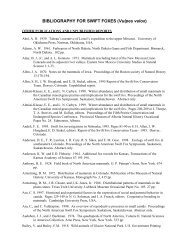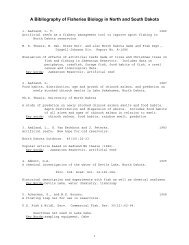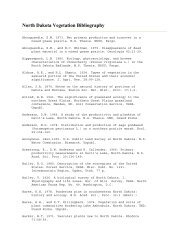PDF Download - Northern Prairie Wildlife Research Center
PDF Download - Northern Prairie Wildlife Research Center
PDF Download - Northern Prairie Wildlife Research Center
- No tags were found...
Create successful ePaper yourself
Turn your PDF publications into a flip-book with our unique Google optimized e-Paper software.
Sargeant, White, Sovada and Cypherrepresented a diversity of habitats, wildlife communities,and land management practices encountered within theranges of swift and kit foxes.Camp Roberts, California, encompassed 172 krn 2 ofrolling hills between the Salinas River floodplain and theSanta Lucia Mountains. Dominant vegetation includedgrassland, oak (Quercus spp.) woodland, and mixed chaparral:kit foxes, however, occurred primarily in grasslandand low- to medium-density oak woodland (Reese et al.1992). The NPRC was located 42 krn southwest ofBakersfield, in Kern County, and comprised 323 km 2 ofrolling hills dissected by steep draws and dry streamchannels. Vegetation consisted of xerophytic shrubs andpatchy herbaceous cover dominated by exotic annualgrasses and forbs. Study areas in Kansas encompassed259 km 2 each. One comprised relatively flat croplanddevoted primarily to production of winter wheat, corn,milo, sunflowers and sorghum. The other included rollinghills of moderately to heavily grazed pastures with a fewcultivated areas interspersed.Temperatures averaged 14°C in winter and 23°C insummer at Camp Roberts, with mean annual rainfall of28.5 cm, and 9°C in winter and 29°C in summer at theNPRC, where mean annual precipitation was only 12.5cm. In Kansas, temperatures averaged 10°C in winter and26°C in summer, with mean annual precipitation of 46.2cm.At Camp Roberts and the NPRC, potential predators orcompetitors of kit foxes included coyotes (Canis lalrans),red foxes (Vulpes vulpes), gray foxes (Urocyon cinereoargenleus),bobcats (Lynx nifits), badgers (Taxidea laxus),and golden eagles (Aquila chrysaelos). Coyotes, badgers,and domestic dogs (Canisjamiliaris) were the only potentialpredators or competitors observed on study areas inKansas.Camp Roberts was used primarily for military trainingand for grazing by sheep and cattle. The NPRC was devotedprimarily to the production of petroleum products.Associated activities included the construction of roads,well pads, and other facilities. Farming and grazing werethe dominant uses of study areas in Kansas.Materials and MethodsData CollectionAt Camp Robelts and the NPRC, we patterned scentstationsurveys after Linhart and Knowlton (1975), asmodified by Roughton and Sweeny (1982). Each stationconsisted of a 0.9-m diameter circle of smoothed earth orsand with an FAS disk (Pocatello Supply Depot, USDA)placed in the center. We placed stations on alternate sidesof unpaved roads at 480-m intervals, in lines of 10. Weplaced lines at least 1 krn apart and distributed them asregularly as possible, subject to the availability of roadsand, at Camp Roberts, to access restrictions in ordinanceimpact areas. At Camp Roberts, we conducted surveys duringautumn (September-November) of 1988; spring(March-May) of 1997; summer (June-August) and autumnof 1989, 1993 and 1995; and spring, summer, and autumnof 1990-92, 1994, and 1996. At the NPRC, we conductedsurveys during summer and autumn of 1984; spring, summerand autumn of 1985-91; and spring of 1992-96. Atboth sites, we operated lines for I night per survey.In Kansas, we constructed stations ofO.37-m 2 (61x61cm) sheets of 18-ga galvanized steel plate coated with carpenterschalk (track plates). We attached a blank scent disk(Pocatello Supply Depot, USDA) soaked in commerciallyprocessed liquefied mackerel in cod-liver oil to the centerof each track plate. During the October survey, we supplemented-60% of track plates with a station composed ofsand, which we mixed with mineral oil (approximately16: 1 ratio) to enhance the clarity and durability of tracks.Sand-and-oil stations were placed -5 m from track platesand had the same dimensions and lure. We placed stationsalong unpaved roads at 500-m intervals, in lines of 17-19,with a minimum distance of 1.6 krn between lines. Weconducted surveys monthly during April-August and inOctober, 1996. During each monthly survey, we checkedstations daily until useable data were collected for 3nights. We considered data to be useable if weather conditionsdid not interfere with the identification of tracks.While conducting surveys, we also collected telemetrydata that showed all stations were placed within homeranges of swift foxes (M.A. Sovada, U.S. GeologicalSurvey, unpublished data).Statistical AnalysisStations, lines, and surveys are 3 common choices ofexperimental units for analyses of scent-station data(Sargeant et al. 1998). We opted for a conservativeapproach. We treated surveys as experimental units whenwe considered several simultaneously (i.e., when testingfor association and for seasonal differences in visitation)and treated lines as experimental units when we consideredsurveys individually (i.e., when comparing trackingmedia). In all cases, we used daily visitation rates (numberofvisitsInumber ofstation-nights) as our population index.SAS (SAS Institute, Inc. 1988) and S-PLUS (MathSoft,Inc. 1997) were used to perform analyses.To test for an association between abundance and dailyvisitation rates, we assumed a monotonic decline in kit foxnumbers at Camp Roberts and used Spearman's rankordercorrelation coefficient (p; Daniel 1990). We appliedthe same method to data from Kansas to test for a seasonaltrend in daily visitation rates during April-August. Weused analysis of variance with year as a blocking factor(Sokal and Rohlf 1981) to test for seasonal differences invisitation at Camp Roberts and the NPRC.To compare tracking media, we used a one-tailed I-testwith October data from Kansas, which we paired by station100Ecology and Conservation of Swift Foxes in a Changing World








